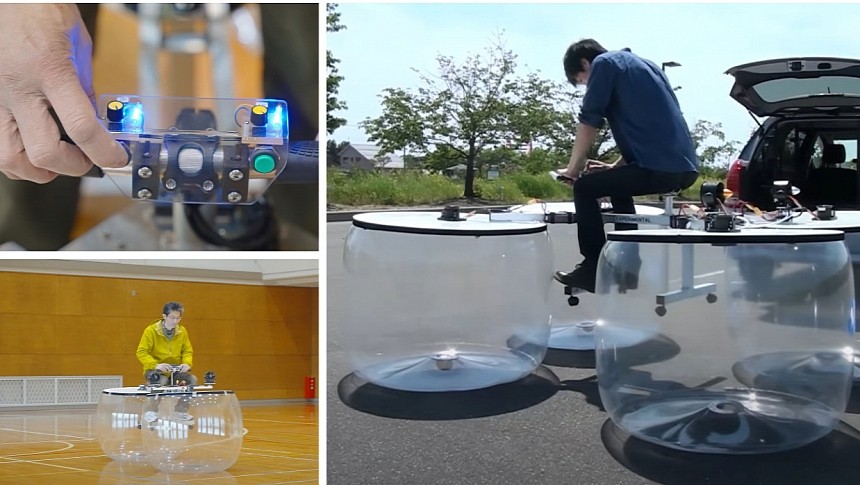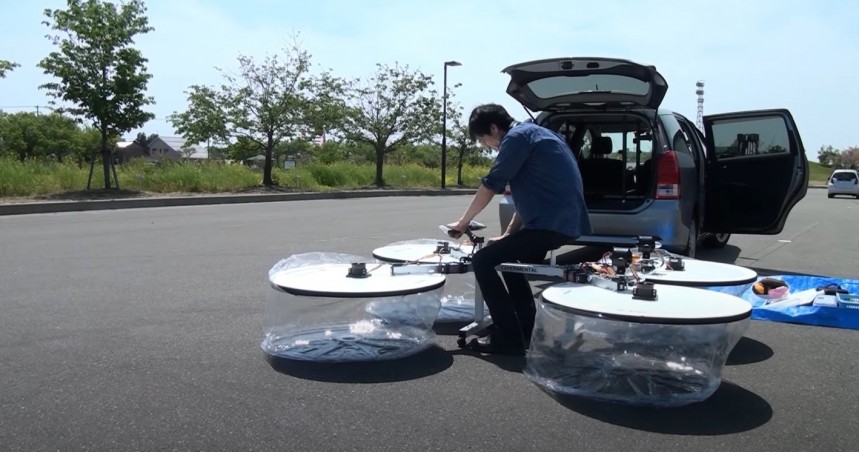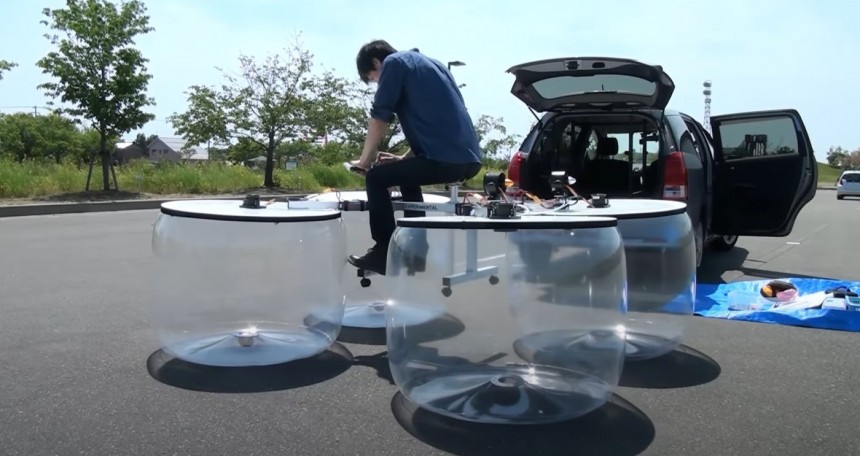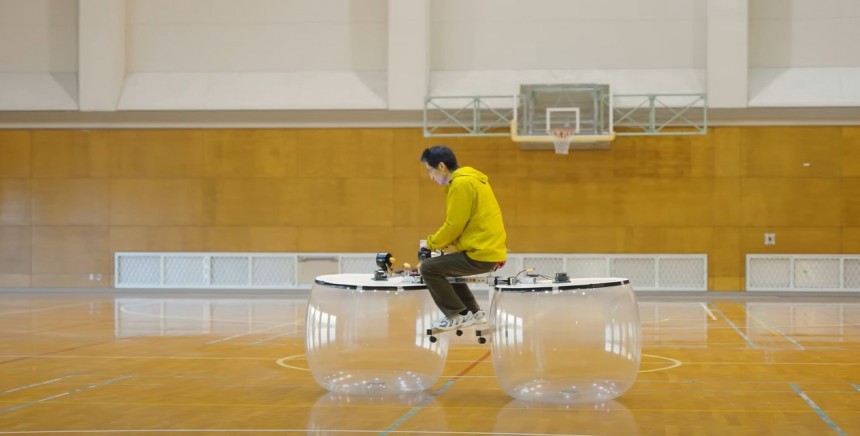Well, this headline is what you might call poetic license in that it needs extra clarification: anyone can build a hovercraft at home, as long as that "anyone" is skilled, hard-working, determined, and willing to invest much of their time and effort in the project.
Anyone can build one such hovercraft at home, as long as they're like Hideyasu Ito, the Japanese inventor and founder of Micro Hoverboard Laboratory. Ito became a viral star earlier this year when a brief video of his latest prototype was picked up by the international media. This also allowed for the first English-speaking interview with him, as YouTuber Tom Scott traveled to Japan for a test ride and a longer chat with the man who had built it.
Recent years and the pressing need for new alternatives for urban mobility seem to have reignited humanity's decades-old dream of individual flight. Flying cars and flying motorcycles seem possible once more, even though they're not technically "cars" or "bikes," but rather VTOLs (vertical take-off and landing aircraft) and oversize drones that resemble quad-bikes.
Some have electric powertrains, and others rely on traditional engines for power, but what they all have in common is the fact that they're not yet here. The field still requires plenty more work both in terms of development of such aircraft and the legislation that would make their use possible in our overcrowded cities, but at least we're hopeful again.
Ito's hovercraft could be one of these vehicles of the future if he keeps at it and the idea takes root. Hovercraft have been around for a very long time, having been invented in the 1950s. During the following decade, they were pushed as a viable alternative for mass transport. A hovercraft is part airplane, part boat, and part helicopter; it's an ACV (air cushion vehicle) that uses fans to inflate a skirt and create a cushion of air on which it glides.
The advantages of hovercraft are numerous and apparently irresistible, and the fact that someone is still trying to make them into a personal mobility solution in 2023 speaks to that. Because they glide on air cushions, they can be used on all manners of surfaces, from water to muddy terrain, rocks, and fine sand. They're also fast and can be used for both people and cargo hauling.
There is a "but," too, and it's what stopped hovercraft from getting off the ground (heh) right from the start. They're very noisy and not exactly cheap to run, while also highly unstable and difficult to control, which makes them very uncomfortable for the passengers. All these are also apparent with Ito's build, which Scott took for a short ride in an empty gym, struggling to make it turn in the desired direction.
That's not to say though that Ito's creation is not notable. For starters, this is perhaps the first "micro" hovercraft designed halfway as a hovercraft and hoverbike. More impressively, the entire build is cheap, with off-the-shelf components like parts from e-bikes or from remote-controlled cars, which Ito buys online. Also online, he sources "specific" small components from China, while the motor is from a leaf blower.
In fact, that's how he got the idea for the project, which is now at its ninth prototype. He bought the leaf blower a decade ago without having any need or plan for it and then started toying with the idea of a hovercraft. Each prototype is different from the other, so he's done several "models" in fact: a kiddie version, a stand-up version, an electric one, and even one that resembles a motorcycle – prototype 9, which is a bit more unstable than the four-air-skirt model but is still usable.
Number 8 features four air skirts and 6 ducted fans, 4 for hovering and 2 for forward thrust. Once the air skirts fill up with air and the air cushion is formed underneath, the operator can rest their feet on the pegs of the trolley, much like they would while riding an electric scooter.
Unlike other hovercraft concepts we’ve seen, this one only achieves a diminutive lift, so it would probably not work on any other surface than the floor of a gym or a neatly paved parking lot, which, in turn, means functionality would be severely limited. You’re not going to “fly” over water and obstacles at considerable height, and least of all, look as badass as you would on something like the $770,000 XTurismo hoverbike. Then again, you’d probably not spend this kind of money, either, for what is essentially a grown-up toy.
Ito doesn’t say what plans he has for the future as regards bringing his creation into production, but he does say that one of his next projects will be to build a pair of hovercraft for the feet. The video that went viral was a demo of Prototype 8 at the DIY exhibition Maker Fair Tokyo 2022, so at least we know that he’s eager to have more people check it out. Based on his social media, he’s also been letting people take test rides on it, so maybe this is not the end of this story.
Recent years and the pressing need for new alternatives for urban mobility seem to have reignited humanity's decades-old dream of individual flight. Flying cars and flying motorcycles seem possible once more, even though they're not technically "cars" or "bikes," but rather VTOLs (vertical take-off and landing aircraft) and oversize drones that resemble quad-bikes.
Some have electric powertrains, and others rely on traditional engines for power, but what they all have in common is the fact that they're not yet here. The field still requires plenty more work both in terms of development of such aircraft and the legislation that would make their use possible in our overcrowded cities, but at least we're hopeful again.
The advantages of hovercraft are numerous and apparently irresistible, and the fact that someone is still trying to make them into a personal mobility solution in 2023 speaks to that. Because they glide on air cushions, they can be used on all manners of surfaces, from water to muddy terrain, rocks, and fine sand. They're also fast and can be used for both people and cargo hauling.
There is a "but," too, and it's what stopped hovercraft from getting off the ground (heh) right from the start. They're very noisy and not exactly cheap to run, while also highly unstable and difficult to control, which makes them very uncomfortable for the passengers. All these are also apparent with Ito's build, which Scott took for a short ride in an empty gym, struggling to make it turn in the desired direction.
In fact, that's how he got the idea for the project, which is now at its ninth prototype. He bought the leaf blower a decade ago without having any need or plan for it and then started toying with the idea of a hovercraft. Each prototype is different from the other, so he's done several "models" in fact: a kiddie version, a stand-up version, an electric one, and even one that resembles a motorcycle – prototype 9, which is a bit more unstable than the four-air-skirt model but is still usable.
Number 8 features four air skirts and 6 ducted fans, 4 for hovering and 2 for forward thrust. Once the air skirts fill up with air and the air cushion is formed underneath, the operator can rest their feet on the pegs of the trolley, much like they would while riding an electric scooter.
Ito doesn’t say what plans he has for the future as regards bringing his creation into production, but he does say that one of his next projects will be to build a pair of hovercraft for the feet. The video that went viral was a demo of Prototype 8 at the DIY exhibition Maker Fair Tokyo 2022, so at least we know that he’s eager to have more people check it out. Based on his social media, he’s also been letting people take test rides on it, so maybe this is not the end of this story.



















